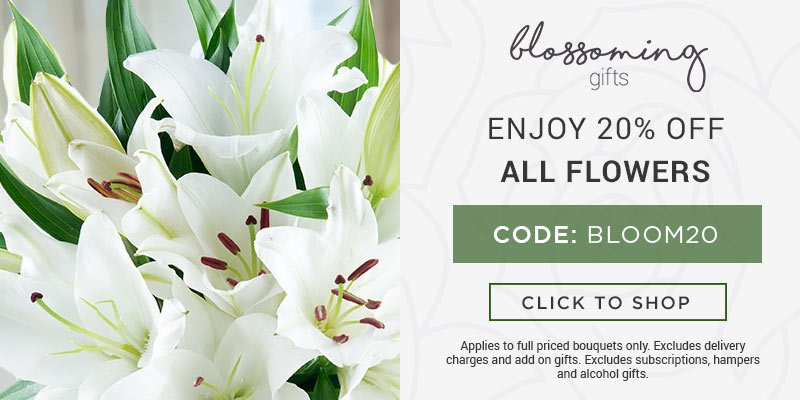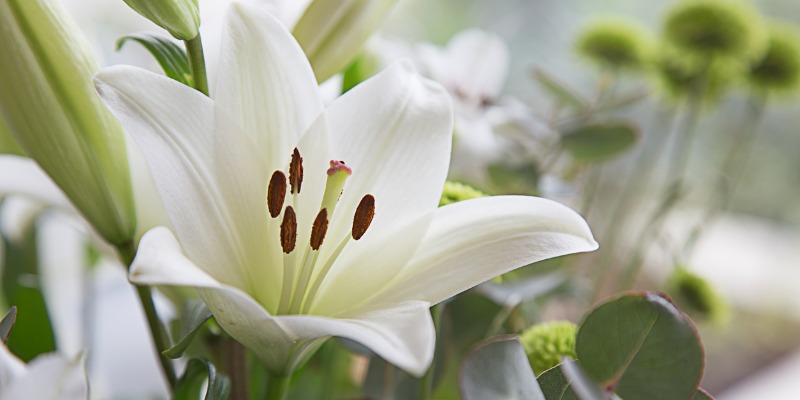Losing those we care about is one of the hardest things we go through in life. When someone in your life has lost someone special to them, you want to support them – but it can be difficult knowing what to do.
Sending flowers is one of the most universal expressions of sympathy in the face of grief. It can be difficult to know what to say or do, and a small token of flowers can go a long way toward letting those left behind know that they are cared for and loved. Sympathy flowers can be used to honour the life of the person passed or to bring comfort and brightness to those left behind.
Feeling overwhelmed by choices at these times is perfectly normal and very common. To help you choose the perfect, personal token of sympathy, we have covered a range of traditional funeral flowers and their meanings. You can also read about the best sympathy flowers to gift according to your relationship with the person or by their faith or religion. We finish with a section of recommended condolence messages to include and appropriate sympathy flowers etiquette.
Traditional Sympathy Flowers & Their Meanings
Across cultures there are many traditional flowers. Drawing from tradition can help give your blooms meaning and depth, and helps us feel connected to a wider community in our grief.
Across traditions, white is the most commonly chosen colour for sympathy flowers. It is often mixed in with blush pinks, pale blues and creams. You are not limited to these colours when picking an arrangement; it is also common to send funeral flowers that are the favourite colour of the person you wish to remember, or in a selection of colours that may better reflect their personality.
Many of the most popular sympathy flowers grow in a dazzling range of colours. Each of the flowers can be arranged in several traditional forms, such as wreaths, standing bouquets or special graveside arrangements and casket sprays.
Chrysanthemums
In many European countries, especially France, chrysanthemums are a traditional flower of death. This began after the first World War when the first Armistice Day was celebrated. The then president of France, Raymond Poincaré, ordered that all the soldiers graves to be decorated with flowers rather than candles, which were the previous tradition. As Chrysanthemums are one of the few flowers still in bloom at that late time of year in France, they were the most prominent in these displays. In the years after the war they came to be seen as a symbol for death, for mourning and for honouring a life. Chrysanthemums would make the perfect token for someone who is more traditional, or perhaps has a military connection.
In China, where they were first cultivated, chrysanthemums represent the change into autumn. They are commonly used to decorate graves and remember loved ones for this reason.
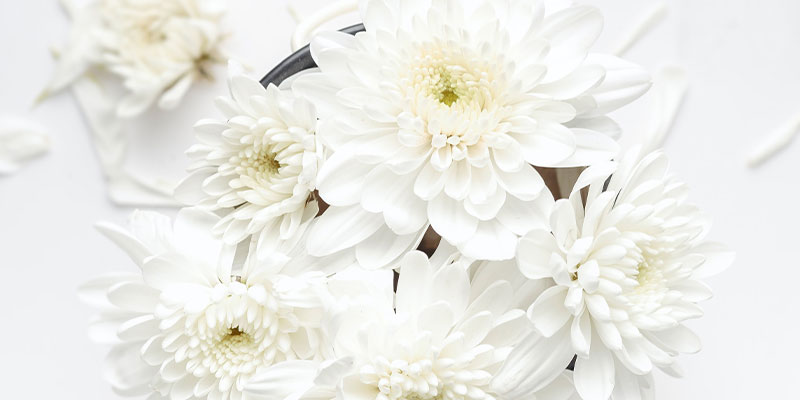
Carnations
Carnations are a common condolence flower in many cultures. Purple carnations are the traditional sympathy flower given in France. In Mexico, carnations of all colours are used to decorate gravesides. Carnations represent love, affection, protection, healing and strength.
As they grow in a wide range of colours, you can use carnations to personalise your sympathy flowers to the spirit of the departed and reflect their personality in your bouquet. Carnations last for a long time once cut, making them a perfect choice for flowers you are sending to a loved one’s home.
Lilies
Graceful, refined and striking, white lilies represent the innocence and purity of loved ones and the sincerity of grief. Their strong perfume has long made them a popular flower for funerals, awakening our senses when we feel most numb.
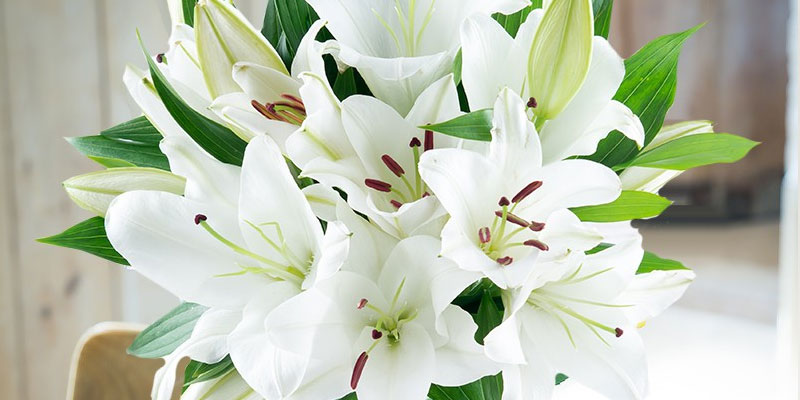
Orchids
A less common choice, gifted either cut or as a plant. Orchids symbolise thoughtfulness and the cycle of life. As Orchids seem to die back and then return to life in full bloom, they are often gifted to remind us that those who have passed are still with us in a myriad of ways. When gifting an orchid plant, you are gifting an annual reminder of the lost persons presence as it bursts back into bloom.
Roses
In present times, roses are one of the most common funeral flowers. Roses are highly regarded in our culture and an easily recognisable symbol of love and affection for the departed.
Each of the different colours has a slightly different meaning. Yellow roses show deeply valued friendship, pink shows gratitude to the departed and red shows deep love and grief. Roses can be mixed in with the participants favourite flower to create a stunning sympathy bouquet with layers of personal meaning.
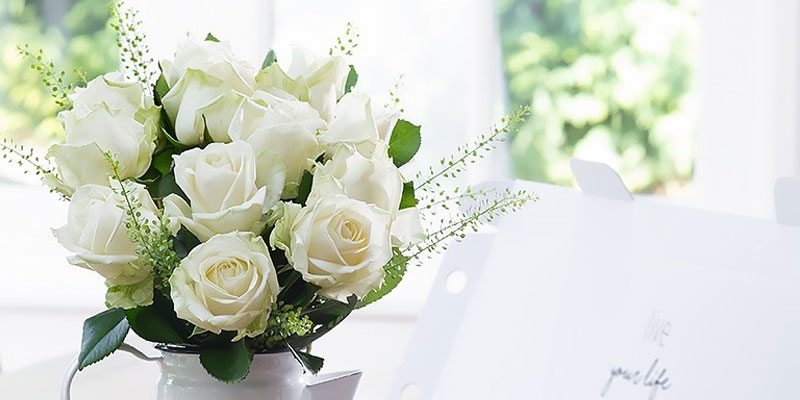
Gladioli
Tall, strong and proud, gladiolus are an ideal sympathy flower for those with a strong character and plenty of integrity.
Sympathy Flowers by Relationship
While the type of flower you choose to send should be picked in consideration to the relationship you have with the deceased, the form you choose to send your flower is perhaps of more importance here. You don’t want to send flowers that would traditionally take pride of place if the family of the loved one have already bought something. See our sympathy flowers etiquette section for more advice on the best sympathy flowers do’s and don’ts.
Funeral Flowers for Someone Close
Choosing sympathy flowers for someone close to you can be incredibly difficult. You may be involved in organising the larger funeral flowers, such as a casket spray, with other close friends or family. When picking sympathy flowers for someone close to you, try and trust your instincts and pick something they would like. There is no right or wrong in a sincere gift.
You could pick a flower they like, an arrangement in their favourite colours or a selection of colours that reminds you of their personality. Alongside a larger display you may wish to add your own small, more personalised, tribute or send sympathy flowers to a family member.
A Family Member
If you are part of the extended family, or perhaps an estranged family member, you can either send flowers to the family home of the person who has passed, or to a specific family member they were especially close with. Attaching a small, thoughtful note is ideal paired with a well-chosen bouquet. If you are for any reason unable to attend the service itself, sending flowers can be an excellent way to show your respects.
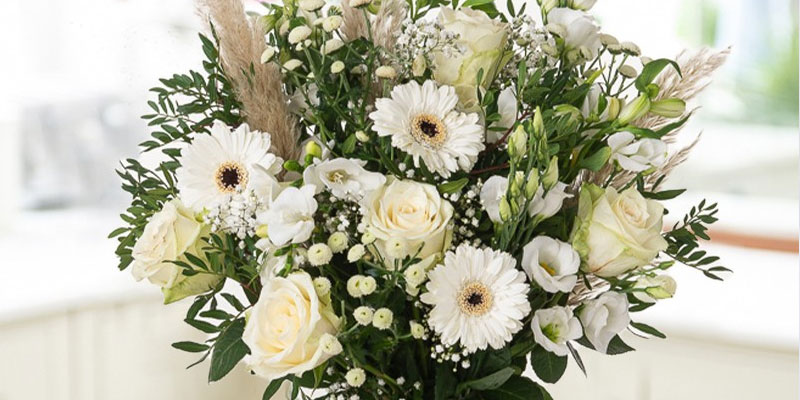
Sympathy Flowers for A Romantic Partner
It can be very difficult supporting your partner as they deal with a loss. Each of us respond to our grief in our own way. It is important to let your loved one know that you are there for them, in whatever way they need. Perhaps pick a more intimate bouquet, sent to their home with a condolences message letting them know they have your support. It can be thoughtful to send a gift of flowers in the long weeks following the funeral to let them know you are still thinking of them, and making space for their grief.
If it is your own romantic partner you are wishing to memorialise with a bouquet, you may wish to communicate with any other close family members that are organising funeral flowers. This way you can have a voice in organising larger floral tributes and also curate a more intimate, personalised wreath to reflect your feeling for your loved one.
The Best Sympathy Flowers for a Friend
A friendship can be hard to summarise in flowers. Sending sympathy flowers for a friend can be a wonderful reminder to the family just how loved their lost one was, and of the positive impact they made to the world around them.
For a friendship group, the family may prefer for you to send one larger tribute as a group. It may be worth asking them for their wishes before ordering. Working together to create a memorial flower arrangement can also be a cathartic and healing moment for the group. If sending from a group of friends, try to avoid in jokes that might be crude or in jokes that make family and other loved ones feel excluded.
Condolence Flowers for an Acquaintance
Stick to smaller arrangements that will be easier for the family to move about. If buying an arrangement as a group, say from colleagues, contact the family or a point of contact from the funeral home before getting a larger arrangement to be sure it fits with the flowers they may have chosen. Sending one arrangement collectively will be easier for the family to manage than several separate small bouquets.

Sending Sympathy Flowers to Different Faiths
For Buddhists stick to white flowers, which are seen as a symbol for mourning, and avoid red flowers. Red is a colour associated with good luck and prosperity, and it would be improper to suggest a funeral was such an event. The dress code for a Buddhist funeral tends toward simpler outfits, with jewellery avoided altogether. As such, reflect this in your choice of bouquet by favouring simplicity and functionality over excessive ornamentation, and contact the organiser first to check if flowers are to be sent at all.
If attending a Jewish, Islamic and Hindu funeral then it is a no to flowers altogether – if you wish to send something, send a gift at a later date instead to let them know you are thinking of them in the lonely months following the funeral. Similarly, it is important for guests to arrive empty handed at Hindu funerals.
If attending a Christian funeral, carnations are a popular choice. It is said carnations were created from the Virgin Mary’s tears, making them a favoured choice. For Mormon funerals, do not include a cross or crucifix in your funeral arrangement. Certain Protestant branches of the church may prefer a plainer arrangement. Eastern Orthodox branches prefer flowers to be sent to the funeral home in the three days between death and burial.
Condolence Messages to Include
Condolence messages don’t have to be lengthy and they certainly don’t have to be perfect. What’s important is to reach out and show you care. It’s okay to admit that you don’t know what to say; sometimes we just don’t know what to write on sympathy flowers. Just let them know you’re there and you care for them. If you’re stuck for words, here are a few prompts:
- You can always ask if there’s anything you need, I’ll be right there.
- You are not alone, and there’s no pressure to talk until you are ready. I’m here either way.
- Include special memories you have of the loved one
- Let them know something wonderful that their loved one did that’s stuck with you
- If it feels right to you, you can include a memory that might make them laugh or smile.
Any combination of the above will let the person know they are in your thoughts. If you’re truly stuck for words, slip a special photo into the card. A picture can often say what we cannot.
Avoid condolence messages that could be seen as telling them how to feel- messages such as “they would want you to be happy,” “chin up,” “be strong.” We can’t control our emotions and guilt at not feeling the ‘right way’ can be a difficult element of the grieving process. If you are not especially close, a simple “so sorry for your loss” is effective and understated.
Including religious messages in your card can be very thoughtful, but there are certainly times when it should be avoided. If you, the recipient, and the departed are all of the same faith it can be of great comfort to share a religious word. If this is not the case, a bit of subtlety may be in order to avoid seeming like you are using a vulnerable moment to push a faith. If you and the departed shared the same faith, perhaps share a comforting message on life or death from your faith. A favoured spiritual message of the departed can be of comfort if you are unsure what to write on sympathy flowers without upsetting the receiver.
Poetry can often help us access our emotions when other words fall short. Including a poem that reminds you of the departed, or has helped you meditate on passing can be a very touching way of sharing space and emotion. Including your own verse can also be a touching tribute.
As well as sending a message, be present with the person if possible and make time to hear them and listen. This can be after hearing of their loss or even months later. Let them know they have a space to talk.
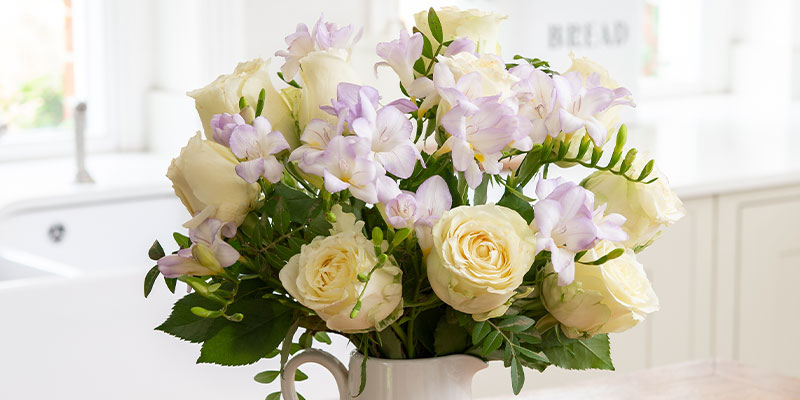
Sympathy Flowers Etiquette
When sending flowers to support a friend or co-worker where you did not know the person who has passed it is especially important to be careful to observe the correct sympathy flowers etiquette.
When to Send Sympathy Flowers?
Sympathy flowers are most often sent as soon as you hear of the news. Some people prefer to send condolence flowers for the time of the funeral, but the family may have many other flowers around the house at this time. You can send flowers if you’re attending in person, or as a sign of your respect if you are unable to make it. If attending the service in person, the best sympathy flowers etiquette is to send flowers ahead of time, rather than hand delivering. This will allow the receiver to be fully present at the service without having to worry about caring for the flowers. It is also common to send sympathy flowers a week or month later to show that you are keeping them in your thoughts.
Alternately, you could send or hand deliver grave flowers months after the funeral to show you are still thinking of the departed, or to help the family in maintaining the graveside.
Where to Send Sympathy Flowers?
It can be confusing to know where to have the flowers sent. For many of us, we are familiar with the idea that funeral flowers are sent, but may not have ever sent or received them before. There are several options. They could go to the persons home, the home of one of their loved ones, the graveside, wake, or the site of the funeral ceremony. Again, there is no right answer and can depend on the impact you want, the flowers you are sending and what your intention is behind sending them.
If you wish to honour the life, sending a basket or wreath to the graveside, funeral home, site of the service or wake can be an excellent option. If you are part of the family, or a close friend, you can send flowers to the family home of the departed. Often the preferred place to send flowers will be listed on the on the funeral announcement. The family may have also left information with the funeral home as to their preferred sympathy flowers etiquette so you can be sure where they would prefer flowers to be sent, or if they want them at all. Check first to get the information you need. If not, reach out to the family and let them decide where they would like your flowers to go.
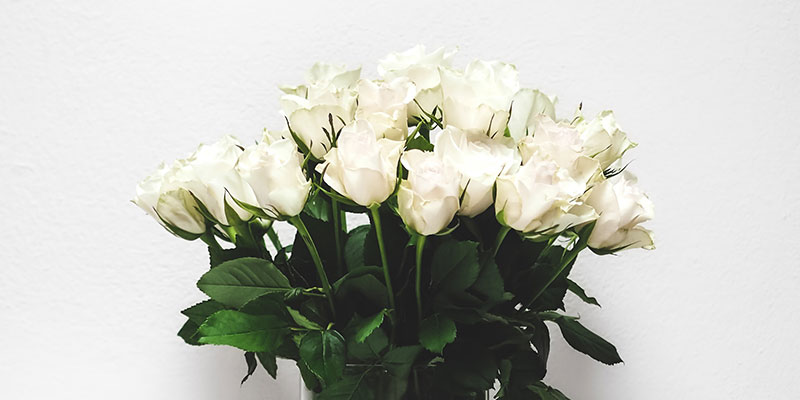
What Types of Sympathy Flower Arrangements to Send?
A self-contained arrangement that can be moved by one person is generally the best rule of thumb to follow. When considering what kind of arrangement to send, you could browse our range of curated sympathy bouquets to get a sense of traditional forms. Unless you are part of organising the service, leave the larger displays aside.
It is also worth noting that a live plant should really only be sent to someone who is good with plants. While the idea of sending something that will stay with them is very touching, it only works if it will stay with them. You would not want to send them an extra chore at this time.
Keeping a Memento
Many wish to keep and preserve a flower from a close one’s funeral, or keep the ribbon from a bouquet. Many bouquets come with a keepsake angel or statue for this precise purpose. It is best to do so on the day of or the day after the funeral as flowers preserve better when fresher, and funeral flowers are often removed within a week of the funeral by staff as they start to perish.
To avoid a misunderstanding, let close family members know of your intention. They may very well want to join you in keeping a small memento. Do so after the funeral has finished and friends and family have moved on, or are moving on, from the graveside so that all may enjoy the flowers as they were displayed. When keeping a memento, it is important to keep in mind the faith and culture of both the receiver and the departed.
Make Space for Yourself
A time that requires sympathy flowers is never an easy one. Whether an acquaintance or a close family member, these events affect us all. The above are guidelines if you are feeling stuck, not a set of rules or expectations for you to meet. Above all, order sympathy and funeral flowers in a way that suits your needs at this time. Sympathy flowers are deeply personal. Do not hesitate to reach out to your florist personally with any requests or thoughts you have, so that we can truly reflect your intention with flowers. If speaking face to face or over the phone seems overwhelming at this moment, you can buy sympathy flowers online, or contact us for advice.
